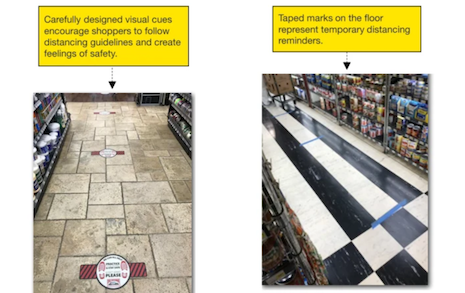- About
- Subscribe Now
- New York,
May 22, 2020

 Forrester report, "Redesign Physical Spaces Now in Response To COVID-19," examines the new normal for shopping. Image credit: Forrester
Forrester report, "Redesign Physical Spaces Now in Response To COVID-19," examines the new normal for shopping. Image credit: Forrester
Luxury brands should use the current shutdown timeframe to be thinking about how they can redesign their physical spaces to make them more hygienic and safe to both consumers and employees.
Consumers will return to the world after life in lockdown with several concerns and companies should do what they can to make their physical environments feel safe and inviting even as the risk of disease remains, according to a new report from Forrester Research. The report explores how companies can rethink their physical spaces to appeal to consumers in a post-COVID-19 world.
“COVID-19 has changed how customers are willing to and want to interact with physical stores,” said Jennifer Wise, principal analyst at Forrester, Boston.
“Their mindsets have changed,” she said. “Forrester data shows that customers are less trusting of organizations and more stressed, and many have concerns for the safety of themselves, their families and employees. Their behaviors towards stores are also different – more want curbside pickup, contactless payment options and online shopping options.
“To get customers back into physical stores, businesses are going to have to redesign their stores to address these customer emotions and fears.”
 Jennifer Wise is principal analyst at Forrester. Image credit: Forrester
Jennifer Wise is principal analyst at Forrester. Image credit: Forrester
Changed mindsets
When the coronavirus pandemic hit the United States in early March, brand energy dropped considerably and that energy has faded since, according to the Forrester report.
Since then, consumers are less willing to trust organizations, have lost their desire for novel experiences and their confidence has dissipated, the report found. As consumers see the economic recession continuing to grow, they are stressed and not necessarily looking to go shopping or out places to spend money.
This mood could last through the year, as health officials have made citizens aware that the virus is still growing in many parts of the country and around the world. And even in those areas that have gotten over the hump, the infection may likely to return in the fall or winter.
Pandemics can cast a long shadow on consumer behavior.
According to the report, fears brought on by the 1918 Spanish flu lasted longer than the flu itself. And this particular COVID-19 pandemic is unlike any other in the massive scale of global shutdown.
“All brands will need to redesign their in-store experiences and implement improved safety measures, design clear signals of those measures to customers, and facilitate easy, independent in-store interactions through measures like new store layouts and digitally augmented in-store journeys,” Ms. Wise said.
“Luxury brands that previously offered high-touch and employee-guided experiences will want to provide alternative means for more independent customer journeys,” she said. “For example, look to augment the store and product experience with additional informative content in-store and online to help customers make decisions.
“Looking into the future innovation roadmap – some companies can consider virtual, sensor-laden products like smart mirrors that offer personalized product recommendations and AR overlays replace or supplement some in-store tactical experiences and employee guidance.”
 Social distancing spacers hint at what retail will look like upon reopening. Image credit: Forrester
Social distancing spacers hint at what retail will look like upon reopening. Image credit: Forrester
Rebuilding trust
As luxury brands work on their reopening plans, customer safety and trust must be front and center to create a positive customer experience.
Redesigning spaces to account for the pandemic will help build this trust.
For instance, when the pandemic hit, essential stores quickly adapted. Stores used tape on the ground to help people measure six-foot distances. They put up plexiglass shields to protect employees and shoppers from close interactions. New cleaning procedures made self-checkout machines cleaned after each use.
As companies create plans to reopen, they should adapt these best practices into new design standards to help ease consumer concerns moving forward.
While some customers will appreciate having their temperatures taken, others will not, so brands should be aware of their customer base.
“Even as fears ebb in the future, customers' behaviors have shifted in ways that will carry on post-pandemic, and experiences that provide added ease and convenience to interactions are here to stay,” Ms. Wise said.
“For example, in response to COVID-19, more U.S. customers report using a digital payment for the first time, more are using contactless payment methods, and more are interacting with services like grocery delivery and curbside pickup,” she said.
“This will accelerate customer familiarity and adoption of these digital experiences and service, and that will leave a lasting impact.”
Share your thoughts. Click here